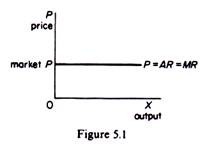Perfect competition is a market structure characterised by a complete absence of rivalry among the individual firms.
Thus perfect competition in economic theory has a meaning diametrically opposite to the everyday use of this term.
In practice businessmen use the word competition as synonymous to rivalry. In theory, perfect competition implies no rivalry among firms.
Assumptions:
ADVERTISEMENTS:
The model of perfect competition is based on the following assumptions.
1. Large numbers of sellers and buyers:
The industry or market includes a large number of firms (and buyers), so that each individual firm, however large, supplies only a small part of the total quantity offered in the market. The buyers are also numerous so that no monopolistic power can affect the working of the market. Under these conditions each firm alone cannot affect the price in the market by changing its output.
2. Product homogeneity:
The industry is defined as a group of firms producing a homogeneous product. The technical characteristics of the product as well as the services associated with its sale and delivery are identical. There is no way in which a buyer could differentiate among the products of different firms. If the product were differentiated the firm would have some discretion in setting its price. This is ruled out ex hypothesis in perfect competition.
The assumptions of large numbers of sellers and of product homogeneity imply that the individual firm in pure competition is a price-taker: its demand curve is infinitely elastic, indicating that the firm can sell any amount of output at the prevailing market price (figure 5.1). The demand curve of the individual firm is also its average revenue and its marginal revenue curve (see page 156).
 3. Free entry and exit of firms:
3. Free entry and exit of firms:
There is no barrier to entry or exit from the industry. Entry or exit may take time, but firms have freedom of movement in and out of the industry. This assumption is supplementary to the assumption of large numbers. If barriers exist the number of firms in the industry may be reduced so that each one of them may acquire power to affect the price in the market.
4. Profit maximization:
ADVERTISEMENTS:
The goal of all firms is profit maximization. No other goals are pursued.
5. No government regulation:
There is no government intervention in the market (tariffs, subsidies, rationing of production or demand and so on are ruled out). The above assumptions are sufficient for the firm to be a price-taker and have an infinitely elastic demand curve. The market structure in which the above assumptions are fulfilled is called pure competition. It is different from perfect competition, which requires the fulfillment of the following additional assumptions.
6. Perfect mobility of factors of production:
The factors of production are free to move from one firm to another throughout the economy. It is also assumed that workers can move between different jobs, which implies that skills can be learned easily. Finally, raw materials and other factors are not monopolized and labour is not unionized. In short, there is perfect competition in the markets of factors of production.
7. Perfect knowledge:
ADVERTISEMENTS:
It is assumed that all sellers and buyers have complete knowledge of the conditions of the market. This knowledge refers not only to the prevailing conditions in the current period but in all future periods as well. Information is free and costless. Under these conditions uncertainty about future developments in the market is ruled out. Under the above assumptions we will examine the equilibrium of the firm and the industry in the short run and in the long run.
